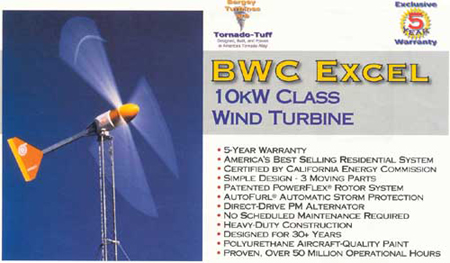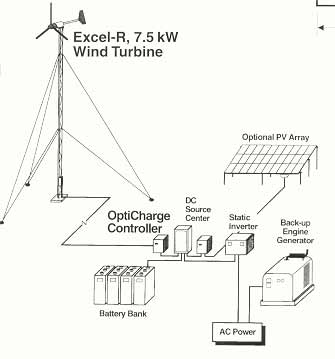
"Make Your Hay While The Sun Shines"
Phanes solar can design a renewable energy source to fit every need. From the operation of a solar powered electric fence to the complete operation of a family dwelling, there is a power source and plan for you.


Shown above is a typical installation utlizing a PV array, backup generator, and a wind turbine. Each serves to charge the battery bank and supply the load with power. The image on the right is a graphic for one of the better selling wind turbines.
Frequently Asked Questions
How do solar cells generate electricity?
Simply put, photovoltaic or PV cells for short, can be thought of as a direct current generator powered by the sun. When light photons of sufficient energy strike a solar cell, they knock electrons free in silicon crystal structure forcing them through an external circuit (battery or direct DC load), and then returning them to the other side of the solar cell to start the process all over again.
The voltage output from a single crystalline solar cell is 0.5V with an amperage output that is directly proportional to cell's surface area (approximately 7A for a 6 inch square multicrystalline solar cell). By combining 30-36 cells together, a working voltage can be obtained. This produces a solar module with a 12V nominal output that can then be wired in series and/or parallel with other solar modules to form a complete solar array to charge a 12, 24, or 48 volt battery bank.
Will solar work in my location?
 Solar is universal and will work virtually anywhere, however some
locations are better than others. Irradiance is a measure of the sun's power available at the surface of the earth and it averages about 1000 watts per square meter.
With typical crystalline solar cell efficiencies around 14-16%, that means we can only expect to generate about 140-160W per square meter of solar cells placed in full sun.
Insolation is a measure of the available energy from the sun and is expressed in terms of "full sun hours" (i.e. 4 full sun hours = 4 hours of sunlight at an irradiance level of 1000 watts per square meter). Obviously diffeent parts of the world receive more sunlight than others, so they will have more "full sun hours" per day. We have a "Solar Radiation Data Manual" that lists the average number of full sun hours per day throughout the year for 230 cities across the United States for both stationary and tracking mount structures. We use this data along with your electrical load information to accurately size a photovoltaic system to meet your needs.
Solar is universal and will work virtually anywhere, however some
locations are better than others. Irradiance is a measure of the sun's power available at the surface of the earth and it averages about 1000 watts per square meter.
With typical crystalline solar cell efficiencies around 14-16%, that means we can only expect to generate about 140-160W per square meter of solar cells placed in full sun.
Insolation is a measure of the available energy from the sun and is expressed in terms of "full sun hours" (i.e. 4 full sun hours = 4 hours of sunlight at an irradiance level of 1000 watts per square meter). Obviously diffeent parts of the world receive more sunlight than others, so they will have more "full sun hours" per day. We have a "Solar Radiation Data Manual" that lists the average number of full sun hours per day throughout the year for 230 cities across the United States for both stationary and tracking mount structures. We use this data along with your electrical load information to accurately size a photovoltaic system to meet your needs.
How much will a system cost for my 2000 square foot home?
There is no square foot average to work from because the cost of a system actually depends on your daily use. To accurately size a system to meet you needs, we need to know how much energy you use per day. You can determine what the average usage is by looking at you electrical bill and dividing by the number of days for that billing statement. This will give us a working point to start from in estimating the cost of a system built to service you needs.
If you plan to build a new house and service it with solar or wind power, fill out the load evaluation form using the estimated values from the amperage and wattage figures and send it to us to complete the estimate for you.
Is solar cost effective?
It depends, if you home is a half a mile or more away from the utility lines, solar can definitely compete with the cost of a utility line extension. Of course when you are comparing the high up front cost of a Photovoltaic system with the cost of bringing power to your site, you should also consider the fact that once a PV system is purchased and installed you no longer have a monthly power bill. Over the course of 20 years that could add up to a considerable savings that PV has over utility power especially with rising power prices. If you home is already connected to the utility grid, going 100% solar will probably not be a cost effective move unless you charge per kilowatt-hour is very high (over $0.25). However, some states offer net metering that allows you to "sell" power back to the utility. Such offerings often allow you to save money by reducing you utility bill.
Can I use all of my normal 120/240 VAC appliances?
Maybe. Many older homes were not designed or built with energy efficiency in mind. When you purchase and install a renewable energy system in you home you become your own power company. Equipment to operate such appliances costs you, the company, more money to install and maintain. Any appliance that operates at 240 VAC are impractical loads to run on solar. However, wind generation could provide sufficient power to supply the necessary current to operate such appliances. Remember, for every dollar you spend replacing inefficient appliances, you will save three dollars in the cost of a renewable energy system to run them.
What components do I need?

There are many components that make up a complete renewable energy system. The 4 main items are wind generator or solar panel array, charge controller, batteries and inverters.
What type of solar or wind generator mounting structure should I use?
For a wind generator the best structure to use is some type of tower. Due to the size of the blades and arch of the blade swing, a tower must be high enough to allow the safe operation of the generator without striking something on the ground. One must take into account what the highest profile would be able to pass under the arch of the blades and them allow extra room for insurance that nothing can be struck by a rotating blade.
Solar panels require less costly mounting systems. Roof top mounts, pole mounts, ground mounts and rotational mounts are all satisfactory.
Where should I mount the solar array and what direction should I face them?
 Mounting
of the solar array or modules is a very important item to consider. To
obtain the best performance you need to determine what direction allows for
full sunlight to fall on the array. You will need to angle the array toward
the sun at different angles during the various times of the year to allow
for tracking the sun. Wind generators are not affected by the position of
the sun and should be considered if trees and other land obstacles block the
sun and prevent you from using a solar array..
Mounting
of the solar array or modules is a very important item to consider. To
obtain the best performance you need to determine what direction allows for
full sunlight to fall on the array. You will need to angle the array toward
the sun at different angles during the various times of the year to allow
for tracking the sun. Wind generators are not affected by the position of
the sun and should be considered if trees and other land obstacles block the
sun and prevent you from using a solar array..
Should I set my system's battery bank up at 12, 24, or 48 VDC?
The PV industry really began with the 12V RV market. These systems were typically small and had all 12 VDC loads. As the solar industry matured and wind generators became more affordable, systems became much larger. The ability to power homes opened up a much larger market and with it a new set of problems. Most homes using renewable energy are setup with either 24 or 48 volt systems.
Should I wire my home for AC or DC loads?
It depends on the size of the system and what type of loads you want to run. DC appliances are usually more efficient than AC since you don't have to worry about the loss through the inverter, but DC loads are typically more expensive and harder to find than their AC counterparts. With the improvements in the inverters over the last five years, AC is the way to go for a home system.
Can I use solar, wind and hydro together to charge one battery bank?
Yes. In fact combining multiple systems is ideal since they compliment each other very well seasonally.
Can I use PV to heat water or for space heating?
No. Photovoltaic converts the sun's energy into DC electricity at a relatively low efficiency level, so trying to operate a high power electric heating element from PV would be very inefficient. To use a solar exchanger to heat water or air would be much more efficient and cost effective.